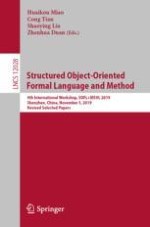2020 | Book
Structured Object-Oriented Formal Language and Method
9th International Workshop, SOFL+MSVL 2019, Shenzhen, China, November 5, 2019, Revised Selected Papers
Editors: Huaikou Miao, Cong Tian, Dr. Shaoying Liu, Dr. Zhenhua Duan
Publisher: Springer International Publishing
Book Series : Lecture Notes in Computer Science
